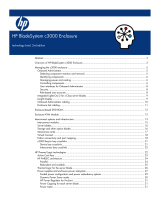
The HP BladeSystem enclosures can accommodate half-height or full-height blades in single- or
double-wide form factors. The HP website lists the available products:
www.hp.com/go/bladesystem/.
Optional mezzanine cards within the server blades provide network connectivity by means of the
interconnect modules in the interconnect bays at the rear of the enclosure. The connections between
server blades and a network fabric can be fully redundant.
A c-Class enclosure also houses Onboard Administrator modules. Onboard Administrator provides
intelligence throughout the infrastructure to monitor power and thermal conditions, ensure correct
hardware configurations, simplify enclosure setup, and simplify network configuration. For some
enclosures, customers have the option of installing a second Onboard Administrator module that acts
as a redundant controller in an active-standby mode. The Insight Display panel on the front of the
enclosure provides an easily accessible user interface for the Onboard Administrator.
Depending on the target market requirements for the specific enclosure, BladeSystem c-Class
enclosures employ a flexible, modular power architecture to meet different power requirements. For
example, the c7000 enclosure can use single-phase or three-phase AC or DC power inputs. As of this
writing, the c3000 enclosure uses single-phase (auto-sensing high-line or low-line) power inputs.
Power supplies can be configured redundantly; they connect to a passive power backplane that
distributes shared power to all components.
To cool the enclosure, HP designed the Active Cool fan. High-performance, high-efficiency Active
Cool fans provide redundant cooling across the enclosure and ample cooling capacity for future
needs. These fans are hot-pluggable and redundant to provide continuous uptime.
General-purpose compute solution
Recognizing that a “one size fits all” solution does not adequately meet customer needs, HP designed
the BladeSystem c-Class as a general-purpose computing solution. A BladeSystem c-class enclosure—
with its device bays, interconnect bays, NonStop signal midplane, and Onboard Administrator—is a
general-purpose infrastructure that can support many different options of server blades, storage
blades, and interconnect devices. BladeSystem c-Class supports ProLiant server blades using AMD or
Intel x86 processors, Integrity IA-64 server blades, StorageWorks storage blades, and interconnect
modules that support a variety of networking standards including Ethernet, Fibre Channel, Serial
Attached SCSI (SAS), and InfiniBand.
Physically scalable form factors
The architectural model for the BladeSystem c-Class uses device bays (for server or storage blades)
and interconnect bays (for interconnect modules providing I/O fabric connectivity) that enable a
scale-out or a scale-up architecture.
Blade form factors
There are two general approaches to scaling the device bays: scaling horizontally in a slim
form-factor, by providing bays for single-wide and double-wide blades; or scaling vertically in a wide
form-factor by providing bays for half-height and full-height blades. After evaluating slim and wide
blades, HP selected the wide blade form factor to support cost, reliability, and ease-of-use
requirements, with the half-height size being optimal for the majority of full-function server blades.
Figure 4 shows both form factors and how a single, wide form-factor device bay can accommodate
either two half-height server blades, stacked in an over/under configuration in a scale-out
configuration, or a full-height, higher-performance blade in a scale-up configuration.
The ability to use either full or half-height form factors in the same space enables efficient real estate
use. Customers can fully populate the enclosure with high-performance server blades for a backend
7




















